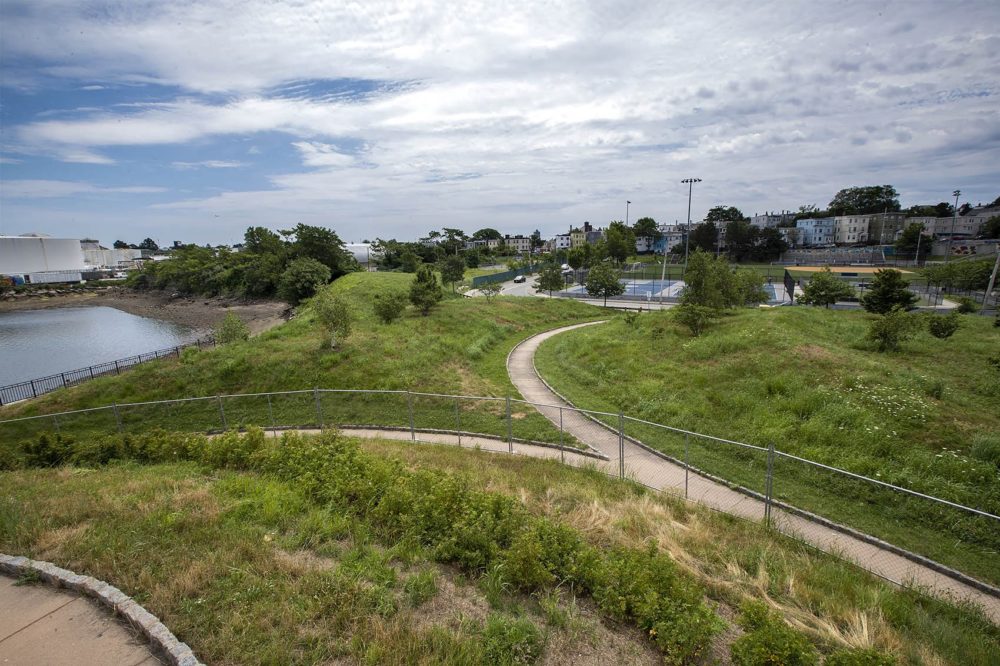Advertisement
Commentary
The Injustice Of Climate Change

We do not all suffer the same climate injustices.
Frontline communities — those shouldering the burdens of environmental, public health and quality of life impacts, for the benefits of our larger region — often go unnoticed. In Greater Boston, the communities along Chelsea Creek, which winds 2.6 miles through Chelsea and East Boston, is just one example.
In massive tanks and open lots along the banks of Chelsea Creek are the storage depots for 100% of Logan Airport’s jet fuel, as much as 80% of the New England region’s heating fuel, and road salt for hundreds of cities and towns in Massachusetts, New Hampshire and beyond.
The threats of climate change exacerbate the daily perils of these industries. Sea level rise is a real and present danger for all coastal communities. Yet, when rising seas are combined with hazardous chemicals and dangerous infrastructure, such as electrical substations, life in frontline communities gets a whole lot more complicated — and scary.

Imagine living next to an electrical substation that, impacted by flooding, has exploded and you must evacuate your family, immediately. Where do you go? How do you get out? What belongings can be salvaged to take with you? When English is not your first language and you aren’t familiar with emergency preparedness, Armageddon can quickly become reality.
After extreme storms, the capacity to rebound, rebuild or relocate is often unrealistic for vulnerable people, who are left to piece together their lives without access to the necessary financial and social resources.
The impact of rising temperatures in summertime is intensified in neighborhoods where parks, trees and open space are sacrificed for corporate interests and regional infrastructure. In communities like Chelsea and East Boston, many neighborhoods are recording ambient temperatures of 20 to 40 degrees higher than in nearby Boston suburbs. These places are home to a phenomenon called “heat islands,” where it’s significantly warmer due to a lack of open, green space. Heat islands are known to exacerbate asthma-related health risks.
The flooding of the Seaport and East Boston waterfront during the 2017 nor’easters served as a wake-up call for Bostonians. The city of Boston launched very public initiatives aimed at identifying neighborhood-by-neighborhood risks and district-specific interventions to mitigate rising seas.
For the residents living along the Chelsea Creek, the effects of climate change are not an abstract concern.
For East Boston, the city has provided a moveable barrier to prevent seawater from flooding down the East Boston Greenway. For Charlestown, there are designs for a raised Rutherford Boulevard to serve as a flood barrier. And, along the Fort Point Channel, the city has proposed a series of earthen berms or sod walls, open park space and seawalls to keep the ocean out of the Seaport.
These climate initiatives are critical. Yet a simple decision to not permit a foolish development can have equal if not greater benefits and protections from climate change.
Consider the proposed electrical substation along the banks of the Chelsea Creek in East Boston. While Climate Ready Boston, the city’s long-term initiative to address climate change, calls for the construction of a living shoreline, the city is instead forfeiting a city-owned piece of land where such a shoreline could be created, to allow the construction of a high-voltage electrical substation.
The $62 million price tag — which will be passed onto ratepayers — is nonsensical and outright dangerous. This substation would be built in a flood zone, in an area that has already flooded several times in the past two years, next to an 8 million-gallon tank of jet fuel, next to two heavily used public parks and in a densely populated neighborhood.

So many of the things Climate Ready Boston and its sister initiative, Greenovate, have proposed are good ideas, and include promising initial steps. But when it comes down to the daily decision-making about building, energy, transportation and land use planning, the best of intentions are secondary to business as usual. We sacrifice our aspirations to practically implement the actions we know are right, to the detriment of some of the state's poorest and most vulnerable residents.
These Chelsea Creek residents, often communities of color, are the same people who have already shouldered environmental burdens for thousands of others in the region. Yet, they are now also the most at risk for the future impacts of climate change.
For the residents living along the Chelsea Creek, the effects of climate change are not an abstract concern. Decision makers must listen to those who are most likely to be impacted by a climate change-driven disaster, as opposed to those who have the most to gain from shortsighted projects. Now is the time to implement climate resiliency strategies, including taking the bold step to prevent the construction of an electrical substation in a flood prone section of East Boston, where residents have borne the brunt of environmental contamination for too long.
This story is part of "Covering Climate Now," a week-long global initiative of over 250 news outlets.

